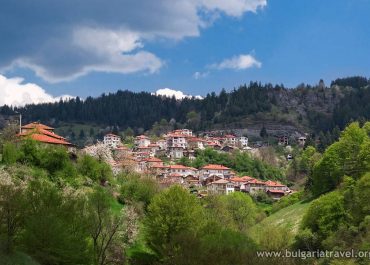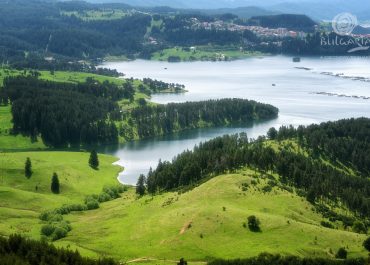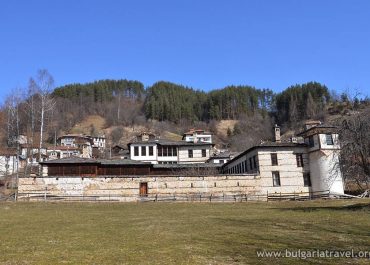
Chepelare
The town of Chepelare is situated in the central part of the Rhodope Mountain, at a distance of about 70 km from Plovdiv and 220 km from Sofia. The main road between Plovdiv and Smolyan passes through Chepelare. The resort Pamporovo is situated at a distance of only 10 km from Pamporovo.
Chepelare is the highest situated town in Bulgaria – 1,100 meters above the sea level. Its climate is temperate continental; the snow cover stays for 80 – 120 days in the year, and its average depth reaches 30 – 80 cm. The town population is about 5,800 people.
The region around Chepelare was populated since antiquity – articles and necropolises from the Neolithic Age, mound necropolises, etc. have been found. In the 5th – 6th century the Slavs founded a settlement here, which had existed until the 14th century when it was destroyed by the Ottoman Turks.
The contemporary settlement was established at the beginning of the 18th century. After the Liberation from the Ottoman Dominion (1878), Chepelare developed as a cultural and educational economic center in the region of Middle Rhodope Mountain.
Chepelare is famous as one of the winter resorts of Bulgaria. Chepelare Ski Center is situated in close proximity to the end of the town, on the way to Pamporovo. The town has long-term traditions in ski sports. The ski tracks and the ski roads of the center are 20 km long. The tracks are of various lengths and difficulty levels and are suitable for advanced, as well as for beginners in skiing and snowboarding. A four-seat ski lift is available for the skiers, which passes the distance of 2,700 meters from the starting point of the station in Chepelare to Mechi Chal peak for 9 minutes.
The only Ski Museum in Bulgaria, which was established in 1998, can be visited in Chepelare. The museum exposition traces the development of ski and ski sports in the town and the country. Visitors can learn interesting facts about some of the most successful athletes in winter sports in the country – Ekaterina Dafovska, Borislav Kiryakov, Mitko Hadzhiev, etc.
The Museum of Rhodope Karst is also situated in Chepelare. It is the only one of its kind on the Balkan Peninsula. Unique exponents are presented inside it – diverse minerals, crystals, the lower jaw of a leopard – an animal which had inhabited the region in the past, as well as a restored skeleton of a cave bear, reaching 4.5 meters height.
The temple “St. Atanasius the Great” is also interesting for tourists. It was built in 1834, for only 40 days. One of the pleasant places for relaxation in the town is the Olimpiyski square.
During the winter the Chepelare region and the nearby resort Pamporovo are suitable destinations for skiers and snowboarders. During the rest of the year the region of the picturesque villages in the Rhodope mountain offer options for country and ecological tourism. Multiple small villages – Bogutevo, Hvoyna, Zornitsa, Orehovo, etc. are spread around the main road from Plovdiv to Smolyan. Various ecological paths start from them. The rock phenomenon The Wonderful Bridges, for example, is situated at a distance of 5 km from the village of Zabardo. The pathway between the villages of Zabardo and Orehovo passes by the bridges. The local people offer accommodation in cozy guest houses, and tourists can sink into the traditional Rhodope atmosphere and taste the local specialties.
The architectural reservation Shiroka Laka is situated at a distance of about 25 km from Chepelare. The village is popular for its beautiful Revival houses, perching on the steep slopes.
The town of Chepelare also offers various accommodation options – hotels situated on the town hills and in its center, guest houses, etc. There are multiple restaurants in the town, where you can taste the delicious Rhodope cuisine.
Tourist information center – Smolyan
Every day: 8:30-12:00; 12:30-17:00
bul. “Bulgaria” № 5
Tel: +359 301 62530
E-mail: toursmolyan@abv.bg
Website: www.smolyan.bg
Tourist information center – Chepelare
Monday – Friday: 8:30 – 17:30
1A, Dicho Petrov Str., town of Chepelare
Tel:+359 3051 81-78
+359 882 362 547
E-mail: tic@chepelare.bg
Website: https://visitchepelare.bg/en/
The town of Chepelare is situated in the central part of the Rhodope Mountain, at a distance of about 70 km from Plovdiv and 220 km from Sofia. The main road between Plovdiv and Smolyan passes through Chepelare. The resort Pamporovo is situated at a distance of only 10 km from Pamporovo.
Chepelare is the highest situated town in Bulgaria – 1,100 meters above the sea level. Its climate is temperate continental; the snow cover stays for 80 – 120 days in the year, and its average depth reaches 30 – 80 cm. The town population is about 5,800 people.
The region around Chepelare was populated since antiquity – articles and necropolises from the Neolithic Age, mound necropolises, etc. have been found. In the 5th – 6th century the Slavs founded a settlement here, which had existed until the 14th century when it was destroyed by the Ottoman Turks.
The contemporary settlement was established at the beginning of the 18th century. After the Liberation from the Ottoman Dominion (1878), Chepelare developed as a cultural and educational economic center in the region of Middle Rhodope Mountain.
Chepelare is famous as one of the winter resorts of Bulgaria. Chepelare Ski Center is situated in close proximity to the end of the town, on the way to Pamporovo. The town has long-term traditions in ski sports. The ski tracks and the ski roads of the center are 20 km long. The tracks are of various lengths and difficulty levels and are suitable for advanced, as well as for beginners in skiing and snowboarding. A four-seat ski lift is available for the skiers, which passes the distance of 2,700 meters from the starting point of the station in Chepelare to Mechi Chal peak for 9 minutes.
The only Ski Museum in Bulgaria, which was established in 1998, can be visited in Chepelare. The museum exposition traces the development of ski and ski sports in the town and the country. Visitors can learn interesting facts about some of the most successful athletes in winter sports in the country – Ekaterina Dafovska, Borislav Kiryakov, Mitko Hadzhiev, etc.
The Museum of Rhodope Karst is also situated in Chepelare. It is the only one of its kind on the Balkan Peninsula. Unique exponents are presented inside it – diverse minerals, crystals, the lower jaw of a leopard – an animal which had inhabited the region in the past, as well as a restored skeleton of a cave bear, reaching 4.5 meters height.
The temple “St. Atanasius the Great” is also interesting for tourists. It was built in 1834, for only 40 days. One of the pleasant places for relaxation in the town is the Olimpiyski square.
During the winter the Chepelare region and the nearby resort Pamporovo are suitable destinations for skiers and snowboarders. During the rest of the year the region of the picturesque villages in the Rhodope mountain offer options for country and ecological tourism. Multiple small villages – Bogutevo, Hvoyna, Zornitsa, Orehovo, etc. are spread around the main road from Plovdiv to Smolyan. Various ecological paths start from them. The rock phenomenon The Wonderful Bridges, for example, is situated at a distance of 5 km from the village of Zabardo. The pathway between the villages of Zabardo and Orehovo passes by the bridges. The local people offer accommodation in cozy guest houses, and tourists can sink into the traditional Rhodope atmosphere and taste the local specialties.
The architectural reservation Shiroka Laka is situated at a distance of about 25 km from Chepelare. The village is popular for its beautiful Revival houses, perching on the steep slopes.
The town of Chepelare also offers various accommodation options – hotels situated on the town hills and in its center, guest houses, etc. There are multiple restaurants in the town, where you can taste the delicious Rhodope cuisine.
Tourist information center – Smolyan
Every day: 8:30-12:00; 12:30-17:00
bul. “Bulgaria” № 5
Tel: +359 301 62530
E-mail: toursmolyan@abv.bg
Website: www.smolyan.bg
Tourist information center – Chepelare
Monday – Friday: 8:30 – 17:30
1A, Dicho Petrov Str., town of Chepelare
Tel:+359 3051 81-78
+359 882 362 547
E-mail: tic@chepelare.bg
Website: https://visitchepelare.bg/en/
Virtual map
Photos
© All images, advertising and video materials and/or other information published on this website are property of the Ministry of Tourism and are protected by the Law on Copyright and Related Rights, according to the Bulgarian laws to all applicable international and relevant acts of the European Union.





